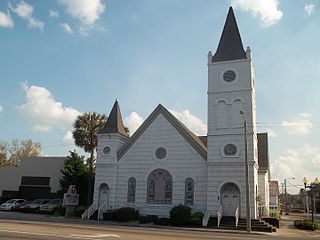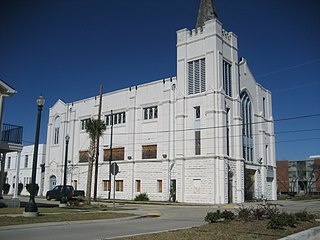
The Mother Bethel African Methodist Episcopal Church is an historic church and congregation which is located at 419 South 6th Street in Center City Philadelphia, Pennsylvania, USA. The congregation, founded in 1794, is the oldest African Methodist Episcopal congregation in the nation.

The black church is the faith and body of Christian denominations and congregations in the United States that minister predominantly to, and are led by, African Americans, as well as these churches' collective traditions and members. The term "black church" may also refer to individual congregations, including in traditionally white-led denominations.

St. John African Methodist Episcopal Church was the first church for African Americans in Nebraska, organized in North Omaha in 1867. It is located at 2402 North 22nd Street in the Near North Side neighborhood. The building is listed on the National Register of Historic Places. The building was constructed in the center of Omaha's North Side in the Prairie School architecture style. Prairie School architecture is rare, and this architectural gem in urban Nebraska is particularly unusual for being designed and built in the 1920s, after the Prairie Style's rapid loss of popularity beginning after 1914.

The St. Paul A.M.E. Church is a historic American Gothic Revival style African Methodist Episcopal Church located in Raleigh, North Carolina. A red brick and frame structure built in 1884 by black masons, St. Paul's was the first independent congregation of African Americans in Raleigh and is the oldest African-American church in Wake County, North Carolina. Before the end of the Civil War, the future founders of St. Paul's had been slave members of the Edenton Street United Methodist Church. The members of the church began calling their congregation "St. Paul's" in 1848. The church was listed on the National Register of Historic Places in November 1987 and is also a Raleigh Historic Landmark.

The S. Edward Hall House in Saint Paul, Minnesota, United States, was the home of S. Edward Hall (1878-1975), an African American businessman and founder of the Saint Paul chapter of the NAACP. It was listed on the National Register of Historic Places from 1991 to 2016.

St. James AME Zion Church is a historic African Methodist Episcopal Zion church located at Ithaca in Tompkins County, New York. It is a two-story, frame church structure set on a high foundation and featuring a four-story entrance tower. The church structure was begun in the 1830s and modified many times since. The original stone meetinghouse was built in 1836 and is believed to be Ithaca's oldest church and one of the oldest in the AME Zion system.

St. Paul's African Methodist Episcopal Church is a historic church in Urbana, Ohio, United States. Built in the Greek Revival style in 1876, it is home to a congregation that was founded in the mid-1820s.

St. Joseph's African Methodist Episcopal Church is a historic African Methodist Episcopal church building located at Fayetteville Street and Durham Expressway in the Hayti District, now a neighborhood of Durham, Durham County, North Carolina.

The British Methodist Episcopal (BME) Church, Salem Chapel was founded in 1820 by African-American freedom seekers in St. Catharines, Ontario. It is located at 92 Geneva St., in the heart of Old St. Catharines. The church is a valued historical site due to its design, and its important associations with abolitionist activity.

The Bethel A.M.E. Church, known in its early years as Indianapolis Station or the Vermont Street Church, is a historic African Methodist Episcopal Church in Indianapolis, Indiana. Organized in 1836, it is the city's oldest African-American congregation. The three-story church on West Vermont Street dates to 1869 and was added to the National Register in 1991. The surrounding neighborhood, once the heart of downtown Indianapolis's African American community, significantly changed with post-World War II urban development that included new hotels, apartments, office space, museums, and the Indiana University–Purdue University at Indianapolis campus. In 2016 the congregation sold their deteriorating church, which will be used in a future commercial development. The congregation built a new worship center at 6417 Zionsville Road in Pike Township, Marion County, Indiana.

Bethel AME Church is a historic African Methodist Episcopal church at 220 Bell Street in Reno, Nevada. It has served as a hub for Reno's African American community since it was built in 1910 for early black settlers. In addition to its role as a religious and community center, it functioned as a resource center for black divorce seekers who faced difficulties in a segregated city during the middle decades of the twentieth century. In the 1960s, during the American civil rights movement, the church provided a meeting place for the local chapter of the National Association for the Advancement of Colored People (NAACP) and other civil rights activists.

The Union Bethel A.M.E. Church in New Orleans, Louisiana, at 2321 Thalia St. at the corner of Liberty St., is a historic African Methodist Episcopal church.

Ethel Ray Nance was an African-American civil rights activist.

People's Methodist Episcopal Church, also known at the Independent Missionary Baptist Church, is a historic church in Colorado Springs in El Paso County, Colorado. Reverend Charles W. Homes was sent from Oskoloosa, Iowa by the Central Jurisdiction of the Methodist Church to build churches in black communities. They church was formed on February 18, 1903, by a group of ex-slaves or children of ex-slaves and began meeting at the Grand United Order of Odd Fellows Hall. The church was built in 1904 in a neighborhood that was predominantly African-American. Prominent early members include Jesse Bass, Lonnie Bassett, and Frank Loper.

Bethel A.M.E. Church is a historic African Methodist Episcopal church located at Richmond, Wayne County, Indiana. The congregation was founded in 1836. The church was built in 1854, and enlarged and remodeled in the Romanesque Revival style with a mix of Neo-classical elements in 1892–1894. It is a one-story, cruciform plan, brick building with a 2+1⁄2-story bell tower. The church serves as an educational, political, and cultural center for the local African American community.

Nellie F. Griswold Francis was an African-American suffragist, civic leader, and civil rights activist. Francis founded and led the Everywoman Suffrage Club, an African-American suffragist group that helped win women the right to vote in Minnesota. She initiated, drafted, and lobbied for the adoption of a state anti-lynching bill that was signed into law in 1921. When she and her lawyer husband, William T. Francis, bought a home in a white neighborhood, they were the targets of a Ku Klux Klan terror campaign. In 1927, she moved to Monrovia, Liberia, with her husband when he was appointed U.S. envoy to Liberia. He died there from yellow fever in 1929. Francis is one of 25 women honored for their roles in achieving the women's right to vote in the Minnesota Woman Suffrage Memorial on the grounds of the State Capitol.

The A.M.E. Zion Church of Kingston is an African Methodist Episcopal Zion Church located in Kingston, New York. Founded in 1848, as a land grant from wealthy Black residents, Mrs. Sarah-Ann Hasbrouck and her husband, Alexander, it is the oldest continuous African-American congregation in Kingston and Ulster County. The church is located at 26 Franklin Street in the city's Fourth Ward.

Mount Zion A.M.E. Church is a historic African American church in Tredyffrin Township, Chester County, Pennsylvania. Built in 1880 and expanded in 1906, Mount Zion was listed on the National Register of Historic Places on January 27, 2015. It was an important community gathering place for African Americans battling racial segregation of local schools in the 1930s.























